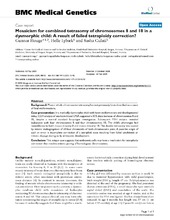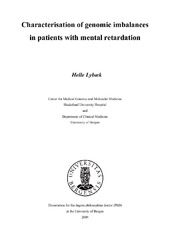| dc.contributor.author | Lybæk, Helle | en_US |
| dc.date.accessioned | 2009-09-07T12:29:40Z | |
| dc.date.available | 2009-09-07T12:29:40Z | |
| dc.date.issued | 2009-03-20 | eng |
| dc.identifier.isbn | 978-82-308-0729-3 (print version) | en_US |
| dc.identifier.uri | https://hdl.handle.net/1956/3439 | |
| dc.description.abstract | A major cause of mental retardation is chromosomal abnormalities, but due to low sensitivity of conventional chromosomal karyotyping, these abnormalities may stay undetected, and the etiology of the impairment remains unknown. With the development of molecular cytogenetic methods, such as chromosome- and microarray-based comparative genomic hybridisation (HR-CGH and array-CGH), genome-wide detection of submicroscopic chromosomal abnormalities has become possible. To examine if implementation of such molecular cytogenetic methods would result in improved diagnostics of patients with mental retardation, we applied HR-CGH and array- CGH on patients with mental retardation to investigate the diagnostic utility of the two methods. In addition, the phenotype-genotype correlations in the patients were examined. By HR-CGH analysis, we found that cryptic genomic imbalances could be detected in five out of 50 examined patients with mental retardation (10%), despite normal findings on conventional karyotyping. Four of the findings were de novo and interstitial. Based on a larger population of 554 patients, the HR-CGH detection rate of cryptic imbalances was 7,2%. Of note, 90% of the findings were de novo, and only 25% of the findings involved a subtelomeric rearrangement. Subsequent analysis of HR-CGH positive samples by 1 Mb array-CGH demonstrated, as expected, a highly improved mapping accuracy of the array-CGH method compared to the HR-CGH method. Application of 1 Mb array-CGH analysis on 20 selected patients with normal findings on both G-banded karyotyping and HR-CGH analysis gave an additional detection rate of 20%, suggesting a high diagnostic yield of the 1 Mb array-CGH method. Three out of the four findings were de novo and interstitial. The capacity for detecting chromosomal mosaicisms by the CGH methods (both HR-CGH and array-CGH) was demonstrated by the unique finding of a mosaic combined tetraploidy for chromosomes 8 and 18 in a newborn with developmental delay, despite normal findings on G-banded karyotyping. The combination of several cytogenetic methods also made it possible to suggest candidate genes that might explain phenotypic features in two different families with mentally retarded individuals. In one family, a ~2,1 Mb sized deletion was located 1,6 Mb distal to a 14q21.1q23.2 paracentric inversion. The deletion involved 16 genes. Among these, SPTB causing spherocytosis, and PLEKHG3, a guanide nucleotide exchange factor for Rho GTPases, and a candidate gene for causing the phenotype of mild mental retardation. In another family, an 8,9 Mb subterminal 19p13 duplication was detected in a 2 ½-year-old proband with severe mental retardation and extreme precocious puberty. Global gene expression analysis did not reveal candidate gene(s) for the hormonal disturbance. The proband´s mother was shown to have a between-arm insertion of the duplicated 19p13 segment into 19q. The same balanced insertion was found in several other family members, including a maternally uncle who was also severely mentally retarded. Unexpectedly, a 3,9 Mb 2q23.3q24.1-deletion was detected in him. The deletion contained seven annotated genes, and of these, FMNL2, a suggested regulator of Rho-GTPases, and NR4A2, an essential gene for differentiation of dopaminergic neurons, are possible candidate genes for causing the phenotype of severe mental retardation. In summary, we have demonstrated the usefulness of HR-CGH and array-CGH as diagnostic tools for patients with mental retardation and have provided detailed genotype-phenotype information on 89 patients. The work also adds knowledge for further understanding of minor or cryptic chromosome imbalances that cause varying degrees of mental impairment, malformations and/or dysmorphism. | en_US |
| dc.language.iso | eng | eng |
| dc.publisher | The University of Bergen | eng |
| dc.relation.haspart | Paper I: American Journal of Medical Genetics 113(2), Ness, G. O.; Lybæk, H.; Houge, G., Usefulness of high-resolution comparative genomic hybridization (CGH) for detecting and characterizing constitutional chromosome abnormalities, pp. 125-136. Copyright 2002 Wiley-Liss. Full text not available in BORA due to publisher restrictions. The published version is available at: <a href="http://dx.doi.org/10.1002/ajmg.10593" target="blank"> http://dx.doi.org/10.1002/ajmg.10593</a> | en_US |
| dc.relation.haspart | Paper II: European Journal of Human Genetics 16(11), Lybæk, H.; Meza-Zepeda, L.; Kresse, S. H.; Høysæter, T.; Steen, V. M.; Houge, G., Array-CGH fine mapping of minor and cryptic HR-CGH detected genomic imbalances in 80 out of 590 patients with abnormal development, pp. 1318-1328. Copyright 2008 Nature Publishing Group. Full text not available in BORA due to publisher restrictions. The published version is available at: <a href="http://dx.doi.org/10.1038/ejhg.2008.78" target="blank"> http://dx.doi.org/10.1038/ejhg.2008.78</a> | en_US |
| dc.relation.haspart | Paper III: Clinical Genetics 74(6), Lybæk, H.; Øyen, N.; Fauske, L.; Houge, G., A 2.1 Mb deletion adjacent but distal to a 14q21q23 paracentric inversion in a family with spherocytosis and severe learning difficulties, pp. 553-559. Copyright 2008 The Authors. Published by Blackwell Publishing. All rights reserved. Full text not available in BORA due to publisher restrictions. The published version is available at: <a href="http://dx.doi.org/10.1111/j.1399-0004.2008.01072.x" target="blank"> http://dx.doi.org/10.1111/j.1399-0004.2008.01072.x</a> | en_US |
| dc.relation.haspart | Paper IV: BMC Medical Genetics 10(42), Houge, G.; Lybæk, H.; Gulati, S., Mosaicism for combined tetrasomy 8 and 18 in a dysmorphic child: A result of failed tetraploidy correction? Copyright 2009 Houge et al; licensee BioMed Central Ltd. Reproduced with permission. Published version. The published version is also available at: <a href="http://dx.doi.org/10.1186/1471-2350-10-42" target="blank"> http://dx.doi.org/10.1186/1471-2350-10-42</a> | en_US |
| dc.relation.haspart | Paper V: European Journal of Human Genetics 17(7), Lybæk, H.; Ørstavik, K. H.; Prescott, T.; Hovland, R.; Breilid, H.; Stansberg, C.; Steen, V. M.; Houge, G., An 8,9 Mb 19p13 duplication associated with precocious puberty and a sporadic 3,9 Mb 2q23.3-2q24.1 deletion containing NR4A2 in mentally retarded members of a family with an intrachromosomal 19p-into-19q between-arm insertion, pp. 904-910. Copyright 2009 Nature Publishing Group. Full text not available in BORA due to publisher restrictions. The published version is available at: <a href="http://dx.doi.org/10.1038/ejhg.2008.261" target="blank"> http://dx.doi.org/10.1038/ejhg.2008.261</a> | en_US |
| dc.title | Characterisation of genomic imbalances in patients with mental retardation | en_US |
| dc.type | Doctoral thesis | |
| dc.rights.holder | Helle Lybæk | |
| dc.subject.nsi | VDP::Medisinske Fag: 700::Klinisk medisinske fag: 750 | nob |

